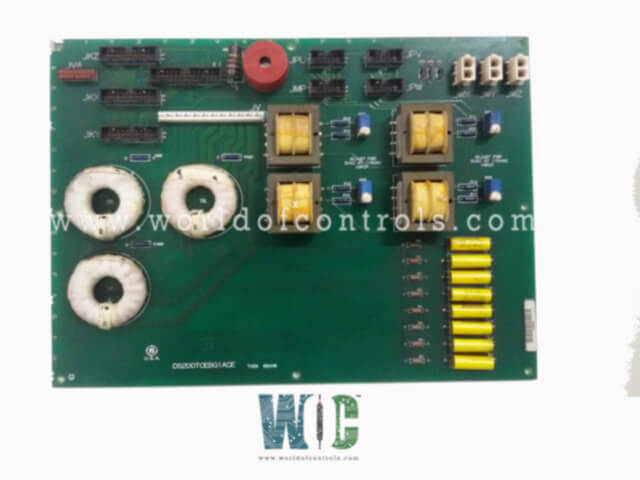SPECIFICATIONS
Part No.: DS200TCEBG1AAA
Manufacturer: General Electric
Country of Manufacture: United States of America (USA)
Product Type: Protective Termination Expander Board
Availability: In Stock
Series: Mark V
Functional Description
DS200TCEBG1AAA is a Protective Termination Expander Board developed by GE. It is a part of the Mark V control system. The Protective Termination Expander Board is a component within the P1 core of the control system. It plays a significant role in scaling and processing various signals used by the TCCB board in the R5 core. The TCEB board is integral to the proper functioning and safety of the control system. By scaling PT and CT signals, processing emergency overspeed and flame detection signals, conditioning and distributing the 335 V DC supply for flame detectors, and integrating the alarm horn, the TCEB board ensures reliable operation and safety of the system. Its central role in signal management and routing highlights its importance in maintaining system integrity and performance.
Features
- PT and CT Signals: The board scales Potential Transformer (PT) and Current Transformer (CT) signals. These signals are vital for monitoring generator and bus voltages as well as line current. Once scaled, these signals are used by the TCCB board in the R5 core for various control and monitoring functions.
- Signal Landing on PTBA Terminal Board: The scaled PT and CT signals, along with other critical signals, are landed on the PTBA terminal board. This centralizes the signal management and facilitates further processing and routing.
- Emergency Overspeed and Flame Detection: Signals for emergency overspeed and flame detection originate from the PTBA terminal board. They pass through the TCEB board, where they are directed to the TCEA boards for processing. This ensures that these critical safety signals are accurately handled and relayed to the appropriate control components.
- Flame Detector Device Power Supply: The board is responsible for conditioning and distributing the 335 V DC needed for the flame detector devices. This high-voltage supply is crucial for the operation of the flame detectors. The 335 V DC supply passes from the boards, across the TCEB board, is conditioned, and then sent to the PTBA terminal board. From there, it is routed out to the flame detector sensors.
- Alarm Horn for Mark V LM: The alarm horn for the Mark V LM (Land Mark) control system is also located on the TCEB board. This integration allows for immediate audible alerts in response to critical alarms, ensuring timely notification of any issues.
Hardware Configuration
- The TCEB board is designed without hardware jumpers. This simplifies the installation and configuration process, reducing potential points of failure and maintenance complexity.
- Alarm horn jumper is located on the PTBA terminal board. This allows for the configuration of the alarm horn functionality, ensuring that the system can be tailored to specific operational requirements.
Software Configuration
- The board requires no software configuration. This design choice further simplifies the setup and maintenance process, making it easier to integrate into existing systems without the need for additional software setup or programming.
Flame Detection Circuit
- Signal Input and Routing: Flame detection signals originate from the PTBA board, entering the control system through the JU connector. This initial connection point allows the system to receive and begin processing these crucial signals, essential for preemptive fire detection.
- Processing on the Board: Upon entering the system, the flame detection signals pass through the Protective Termination Expander Board (TCEB). Here, specific conditioning is applied to the 335 V DC signals associated with flame detection. This conditioning process ensures that the signals maintain stability and integrity throughout their journey within the control system.
- Transmission to TCEA Boards: Following conditioning on the board, the processed flame detection signals are transmitted to the TCEA boards. This transfer is facilitated through the JKX, JKY, and JKZ connectors, which efficiently relay the conditioned data for further analysis and integration into the control framework.
- Routing and Integration: Within the TCEA boards, the flame detection signals undergo additional routing and processing via the JWX, JWY, and JWZ connectors. These connectors play a pivotal role in preparing the signals for their eventual return to the PTBA board, ensuring seamless integration and utilization within the broader control system architecture.
The WOC team is always available to help you with your Mark V requirements. For more information, please contact WOC.
Frequently Asked Questions
What is DS200TCEBG1AAA?
It is a protective termination expander board developed by GE under the Mark V series.
How are PT and CT signals processed in the control system?
Upon reading from the PTBA terminal board, PT and CT signals undergo step-down processing. They are then transmitted to the TCCB board located in the R5 core via the JMP connector. This ensures that the signals are accurately utilized for embedded functions within the control system.
Where is the configuration for PT and CT signals performed?
Configuration associated with PT and CT signals, including adjustments and settings, is performed within the R5 core of the control system. This centralizes the management of signal configurations, ensuring consistency and efficiency in their use across operational functions.
What are embedded functions on the TCCB board?
The TCCB board in the R core utilizes PT and CT signals for embedded functions. These functions may include real-time monitoring, control responses, and safety protocols based on voltage and current data, contributing to enhanced operational oversight and system reliability.
